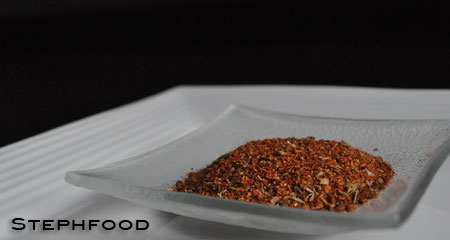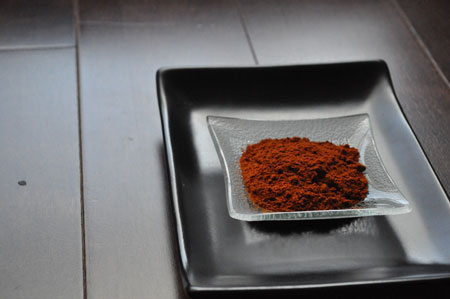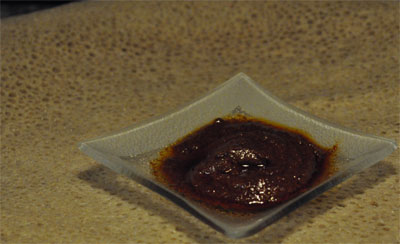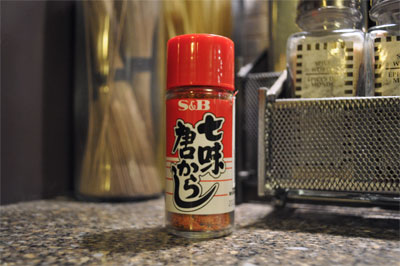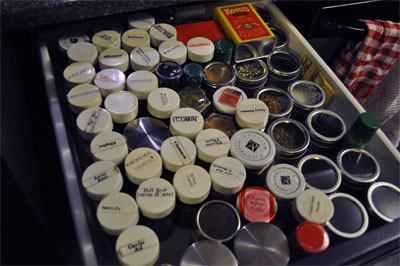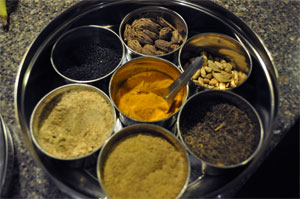
I first tried Ethiopian food about 10 years ago, on the recommendation of a colleague. A vegetarian at the time, I was looking for new restaurants, and new flavours that didn’t involve eating Babe (or his little friends). When I go for Ethiopian food, I always get the vegetarian platter. All of the restaurants make these, and they often contain many of the same dishes (or variations of them). Comprised of a number of stews, the dishes may be spiced legumes (lentils, split peas), vegetables, collard greens, all placed in colourful mounds around a fresh salad, atop what can best be described as a sourdough pancake.
Injera, the aforementioned ‘pancake’, is an important part of the meal. It lines the platter, it provides the grain portion of the meal… and acts as your utensil. The flavourful stews are grabbed up, and masterfully rolled into a piece of injera, dipped in Awaze, and quickly popped into your mouth. Injera can be made at home, or bought from a number of stores that carry the handmade bread. It is traditionally made from Teff, the world’s smallest grain, which can be hard to find and expensive in Canada. We opted to buy Injera this time around, but my husband “the bread guy” thinks he could pull off a good batch next time (having found Teff flour at Rube’s in St. Lawrence Market).

A close-up of the platter. Clockwise from 12: Gomen, Mesir Allecha, Mesir Wat. Centre: Awaze. MMmmmmmm.
This meal is great for those who love complex flavours, varied textures, a little spicy kick and breaking ripping bread with friends.
This was my second attempt at making Ethiopian dishes. The first try did not go so well, and I gave up. This time, I figured I had a better feel for the food, hopefully a better eye for the recipes, and a new favourite condiment to devour.
In my earlier post, I mentioned Berbere, a very important spice blend in many Ethiopian dishes. I also mentioned Awaze, the bold and spicy condiment that is made from Berbere. This is my inspiration for trying again, and having successfully made a batch of Awaze, I was determined to make food worthy of being dipped in it.
Want some injera or spices? Toronto has quite a few places that carry these items, but the ones that we shopped at this time around are Piassa Ingera (260 Dundas Street East) and, oddly enough, the Hasty Market at King & Dufferin.
Looking for someone else to make it for you? Try Ethiopian House Restaurant (4 Irwin Avenue, Toronto)
Want to try making it for yourself? Here are recipes I followed (slightly modified from recipes I found online). Don’t forget to refer to the Berbere and Awaze post!!!
Niter Kebbeh (spiced, clarified butter)
This is the start of many great Ethiopian dishes. This butter is full of flavour, and really can’t be omitted from the dish (although I generally use less than recommended in the original recipes). I made this well in advance, let it cool in a rectangular dish, then chopped into cubes and frozen. I should have enough Niter Kebbeh for the next 3-4 meals, maybe more!
Modified from this Recipe
Ingredients:
- 1 pound butter
- 4 tablespoons onion, finely chopped
- 1 1/2 tablespoons garlic, finely chopped or pressed
- 2 teaspoons fresh ginger, scraped and finely grated or minced
- 1/2 teaspoon turmeric
- 4 green cardamom pods, crushed
- 1 cinnamon stick
- 3 whole cloves
- 1/8 teaspoon ground nutmeg
Preparation:
- Slowly melt the butter in a medium-sized saucepan over low heat.
- Add the other ingredients and simmer uncovered on the lowest heat for about 20-30 minutes. Do not let it brown.
- Strain the mixture through a double layer of cheesecloth or a fine strainer, discarding the spices.
- Refrigerate until set.
Gomen (Stewed Collard Greens)
The collard greens have always been one of my favourite parts of the meal. Their slightly bitter, buttery deliciousness is a great contrast to the lentil dishes and is a must for any platter. I actually doubled this recipe when I made it, and found that this was the perfect amount.
modified from this recipe
- 1 large bunch collard greens, about 1½ pounds
- 1 tbsp niter kebbeh, ghee or olive oil
- 1 red onion, chopped
- 2 cloves garlic, minced
- 1-inch piece fresh ginger, peeled and minced
- 2 fresh hot peppers, seeded and minced (or to taste)
- 1 cup broth
- ½ teaspoon salt
- ¼ teaspoon
- black pepper
- ½ teaspoon cardamom
- Tear stems from collard greens, and wash greens well.
- In a large skillet or stir fry pan, melt the niter kebbeh (or oil). Add onion, garlic, ginger and hot peppers and simmer, stirring occasionally, about 5 minutes.
- Add collard greens, broth, salt, pepper and cardamom. Bring to a simmer and cook until most of water has evaporated from pan and the greens are very tender (this took me about 1/2 hour… leave some time!).
Mesir Wat (spicy red lentils)
This is my absolute favourite dish in the platter. The lentils are soft and spicy and creamy. The berbere spice is really hard to describe in this dish, as it adds not only spice but a really well-rounded warmth and flavour. This recipe makes a LOT of food, and could be halved (especially if made alongside the other two recipes here). I made the full recipe, and have quite a lot left over… but I’m fine with that. Did I mention this is my favourite? I may try freezing some to see how it holds up.
Serves 4 to 6 – modified from this recipe
Ingredients:
- 2 onions, chopped
- 1 cloves of garlic, crushed or finely minced
- 2 tsp ginger, peeled and minced or grated
- 2-3 tbsp Niter Kibbeh (or oil or butter)
- 3 tablespoons berbere
- 2 cups red lentils, rinsed
- 4 cups, water or broth
- salt & pepper, to taste
Method
- Place the onion, garlic and ginger in a food processor or blender and puree. Add a little water if necessary.
- Heat the oil, butter or niter kibbeh in a large, heavy-bottomed saucepan over medium flame. Add berbere and stir rapidly to color the oil and cook spices through, about 30 seconds.
- Add the onion puree and sauté until the excess moisture evaporates and the onion loses its raw aroma, about 5-10 minutes. Do not burn.
- Add lentils and water to the saucepan. Bring to a boil, reduce heat to low, and simmer, uncovered, until lentils are cooked through and fall apart, about 30 to 40 minutes. Add water if necessary to keep the lentils from drying out.
- Stir in salt and pepper to taste and serve.
Mesir Allecha (mild lentils)
These lentils are mild and buttery. Although not the most stand out dish of the bunch, for me it offers a mild balance with the other dishes. I chose this dish to round out my platter. This recipe makes a conservative amount – which was fine with me, because I eat less of this one than the other two. Notice that the recipe calls for half the amount of lentils required in the Mesir Wat above.
modified from this recipe
Ingredients:
- 1/3 cup onion, chopped
- 2 garlic cloves finely minced or pressed
- 1 tablespoon niter kebbeh
- 1 cup red lentils (masoor dal), picked over, rinsed and drained
- 1/2 teaspoon turmeric
- 1/2 teaspoon salt
- 3 teaspoons seeded and finely chopped jalapeño peppers
- 4 cups water (adjusted as necessary)
- In a medium saucepan, soak red lentils for one hour in three cups of the water.
- Bring the lentils and water to boil and cook for 30 minutes until the lentils are soft, adding more water if necessary. Drain off any extra water and mash.
- Heat the niter kebbeh in another pan over moderate heat. Add the onion and garlic and cook for 3 minutes. Add the mashed lentils, turmeric, salt and hot pepper. Stir well.
- Add the remaining cup of water (or less, pour slowly) and cook for 3-4 more minutes more to reduce the mixture to a thick, well spiced puree.
